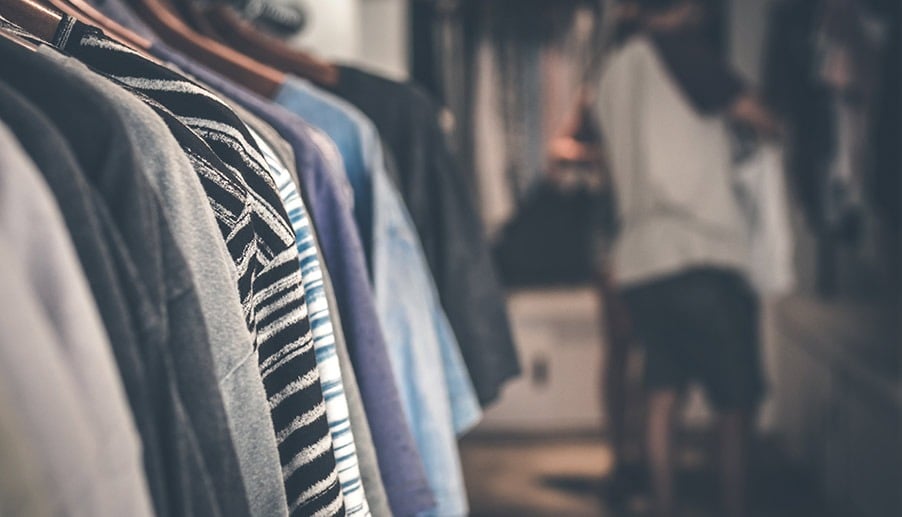
Our environment is under immense pressure. Large corporations continue to pollute. World leaders continue with their lack of action on climate change. But you can help fight against the destruction of our planet with small lifestyle changes, including your clothing.
Here are the easiest ways to make your wardrobe more eco-friendly: buy sustainable fabrics, ditch real leather, embrace slow fashion, don’t buy unnecessary, buy second hand, swap clothes with others, and research companies before buying their clothes.
This article aims to provide you with all the information on how to be eco-friendly with clothes. We hope you will join us in the fight against environmental destruction with these small changes.
The Importance of Going Eco-Friendly
Our planet is delicate. The more our population grows, the more things we need to produce. Oil, gas, raw materials and animals are all used by humans to create consumer goods. This takes a considerable toll on our environment.
Carbon Footprint
The carbon footprint of items is based on the amount of carbon dioxide (CO2) required to produce them. Services and people also have carbon footprints. The higher the carbon footprint, the more detrimental to our environment.
C02 is essential to all life on earth. However, too much C02 in our atmosphere is a bad thing. C02 gets trapped in our atmosphere, this is known as the “greenhouse effect”. As the volume of gas increases, it is trapped within our atmosphere, this drives up the average temperature of our planet. This is known as “global warming”.
Global warming poses a serious risk to our planet and all life, including us. The consequences could range from adverse weather effects to the complete loss of entire islands and coastal regions due to rising sea levels.
Being aware of your carbon footprint and the products/services you use is extremely important.
Pollution
Pollution comes in many forms, including air, land, water, and soil. Each poses a severe risk to us, our environment, and wildlife. We now have a serious and complex issue with pollution all across the globe.
Human-made phenomenons such as the Great Pacific Garbage Patch are indicators of just how much of a negative impact our species is having on the planet.
Plastic pollution is a particular issue with many plastic materials taking up to 500 years to naturally decompose. During this time, the plastics leach toxic chemicals into the air, and into our soil further polluting the earth.
Many plastics find their way into our rivers and oceans before even getting the chance to decompose. They usually end up in the stomachs of marine wildlife or birds.
We can make meaningful and better choices when it comes to our lifestyle, our consumerism, and the way we dispose of waste.
7 Easy Ways to Make Your Wardrobe More Eco-Friendly
So now we understand why we should be more eco friendly, here are some great ways on how to be eco-friendly with clothes and minimize your impact on the environment when it comes to your wardrobe.
1. Buy Sustainable Fabrics
Sustainable fabrics are materials that come from eco-friendly sources, production methods and can be recycled or reused once finished with.
Cotton, for example, uses vast amounts of water during its production, making it very unfriendly to the environment. Denim is similar, talking up to 1800 gallons of water to create one pair of blue jeans!
Sustainable fabrics you want to look for include:
- Bamboo
- Linen
- Hemp
- Cotton (organic only)
- Lenzing Tencel
- Silk
It’s essential to make sure that each material is certified organic. This will ensure you’re buying fabric from the most eco-friendly source. Organic simply means that the raw material of the clothing has been grown in compliance with various organic agricultural standards.
Bamboo is a fantastic eco-material as the bamboo plant is ultra-sustainable. It grows at a rapid rate with no need for harsh chemicals or pesticides for its cultivation. Bamboo is also very durable, meaning clothes will last longer, and it is also 100% compostable.
2. Ditch the Real Leather
Leather is mostly a by-product of the animal agriculture industry. To transform animals hide into the leather that you buy in a clothes store, it must go through an intense and resource-heavy process.
The animal agriculture industry is also one of the leading causes of carbon emissions in the world. Therefore, each time you buy a piece of leather, you’re purchasing the long-term carbon footprint of the cow, the farming industry, and the intense production method.
Thankfully, you can now buy faux leather made from anything from pineapple to corn. Plant-based leather is one of the top trends in fashion right now. This trend has developed as a by-product of the vegan movement.
Plant-based leather requires a lot fewer resources to create and uses materials that would otherwise go to waste. Pinatex is a leather made from pineapple leaves that are a waste product from the pineapple industry.
3. Embrace Slow Fashion
One of the most significant issues with modern fashion is the speed in which clothes are produced, bought, and then thrown away. This is known as “fast fashion.”
Fast fashion is detrimental to not only the environment but to human rights also. Many workers are paid below a living wage to work for up to 14 hours a day to create cheap pieces of clothing.
You can fight back against fast fashion by embracing slow fashion. Someone who adopts slow fashion only buys clothes that have been produced responsibly.
Slow fashion goods are usually made with sustainable materials. The workers involved are treated fairly, and the products are made to last. The consumer gets a fair price in-store and holds onto that piece of clothing for as long as possible.
This helps people to buy only quality and buy less. Everyone involved gets a fair deal.
4. Don’t Buy Unnecessarily
The best eco-friendly choice you can make when it comes to fashion is not to buy anything at all. As a society, we simply consume too much. Fashion is no exception, with many people buying clothes on a monthly or even weekly basis.
This year, only buy absolutely necessary clothing. Wear the same dress more than once. In fact, wear that dress all year if you want to. The less we buy, the less that needs producing and the less strain we put on the environment.
Only buying the essentials works nicely with the slow fashion movement. If everyone only buys the clothes they need, and those clothes are eco-friendly and durable, we can help to mitigate a lot of the environmental and human rights issues in the fashion industry.
5. Buy Second Hand
Thrift shops have become increasingly popular over the last decade and for a good reason. Why buy new clothes if there are already millions out there on sale second hand?
You can shift your mindset from wanting new clothes to buying great second-hand pieces. Not only will you dramatically reduce your negative footprint on the planet, but you will help to support local businesses in your area too.
We already have enough clothes for everyone on earth ten times over. Let’s start buying each other’s old clothes so that we don’t need to produce as many new items.
6. Swap Clothes
Instead of buying other people’s old clothes, you could swap clothes with friends or strangers. Clothes swaps are another trend that seeks to minimize our impact on the planet.
Clothes swaps have now become popular events happening all over the world. Some groups of friends even have annual clothes swap parties. Everyone brings their unwanted clothes to the party and swaps them with friends for their unwanted clothes.
Each person then gets a set of new clothes, and no one had to buy anything new from the store. Check on Facebook for a local clothes swap meeting. If there isn’t one, create your own with your friends!
7. Research Before You Buy
Unfortunately, we live in a world where “greenwashing” exists. This is where popular brands or companies give consumers the impression they’re eco-friendly or ethical without actually living up to those values.
Companies like H&M use green labels and eco-friendly buzzwords such as “sustainability” or “eco-friendly” even though their clothes don’t represent these values.
Make sure you do your research on brands you want to buy from. Don’t take their word for it. Instead, research into their story and production methods. Check their online sustainability score and read customer reviews.
Greenwashing is confusing many with false ideas of what eco-friendly and sustainability means. Don’t fall victim to these shady marketing tactics.



